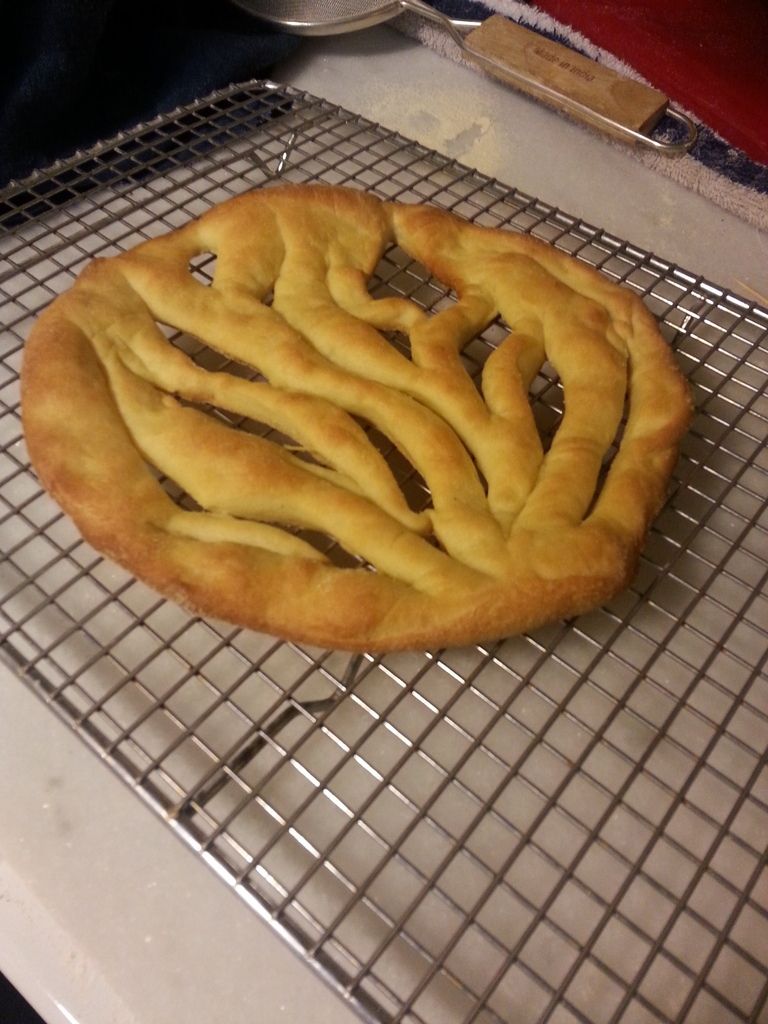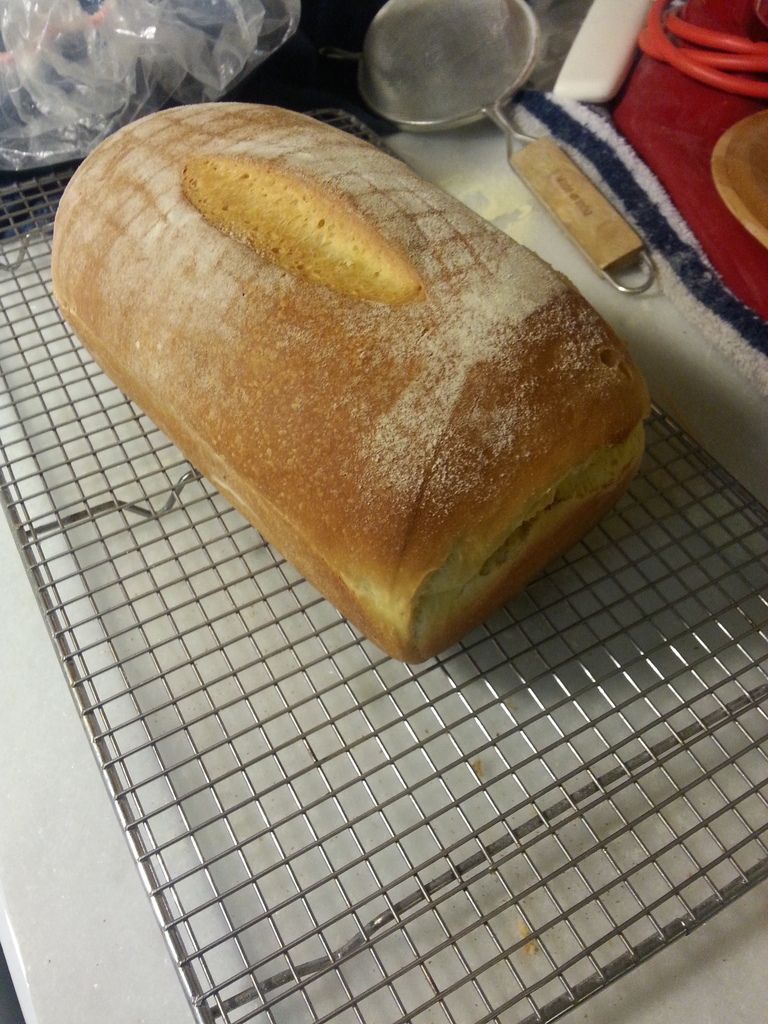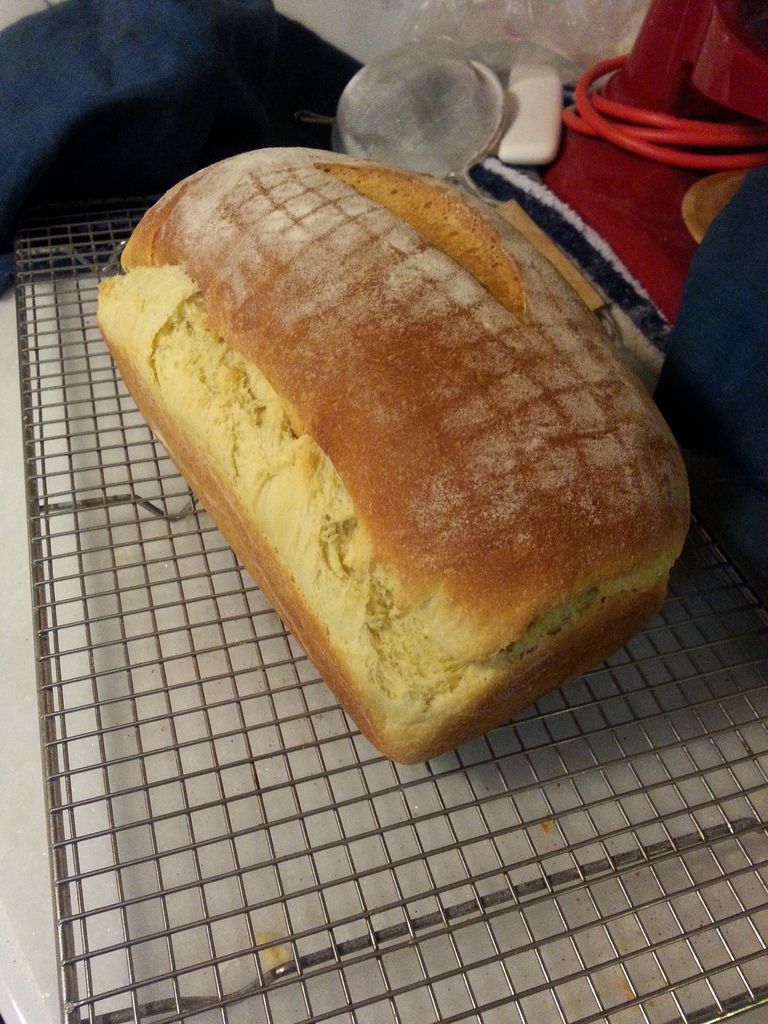Well I have been getting excited about making croissants this weekend and figured it would be nice to make something easy tonight to get me in the mood for the weekend. I've been trying some new things lately and purchased a bag of durum wheat flour to use to make some Italian breads...I bought GM extra fancy and it is very fine grained compared to other Semolinas I've had.
Decided to make a 100% Semolina sandwich bread from Local Breads (Leader) and found it very easy to work with and incredibly silky once kneaded. Easily doubled in about 2 hours so pre-shaped and gave it about ten minutes to relax (maybe needed more?). Shaped it and loaded it into a pan to proof for about another 1-1/2 hours. Seemed full of life so I gave it a very small score to give it a way to release...anyway, I've never made this bread before, never used Durum flour before but my thoughts were that it had plenty of fermentation and proofing and my only consideration would be lack of degassing (been making a bunch of SD bread lately so the habit is to not or only lightly degas). My shaping is always suspect and even though it looks as if it 'blew a seam' the seam is clearly visible on the bottom of the loaf.
Anyway, the rather ugly fougasse was quite delicious and coincidentally didn't have blow up issues...guessing because I actually got the air out.



My real source of confusion (aside from not knowing what I'm doing;-)) is that the blowout seems to have occurred rather late in the bake as it was so lightly baked where it tore. Looking at the pictures I would just think underproofed but I don't know how considering how it felt and looked at each step...easily doubled and rather poofy.
Thought is to try again with a bit less yeast and push the fermentation longer...then degas better. Loaf looks fine to me on the inside and tastes very good (probably taste better if I could tame it a bit).
Here's an after the fact crumb shot.

Thanks
I would agree with you that it was under proofed and has blown because of that. This can happen rather late. Especially because you were baking in a pan. Not long ago I was making a special kind of cake like Italian pannetone in a special model and I was surprised how late the dough broke.
Probably the best method to know when the dough is ready for oven is the finger poke test, but also this can be sometimes unreliable.
Happy baking!
Joze
Thank you Joze!
Back to the draw drawing board;-)
Believe I'll try it with a bit less yeast to slow the process a bit...and then practice my finger poke test.
If you would score more there would be less chance for blowout. When you bake in a pan then the dough keeps it form. When doing bold free style bake then the dough will spread and the area exposed to heat is definitely bigger. This means that the dough is heated faster and in case of bad scoring or under proofed loaf the blowout will happen earlier. While in the pan heating (absorbing) area is smaller and therefore the dough warms up slower and it takes longer that the middle of the loaf becomes stiffer. Obviously in your case happened this. With a free style loaf you would probably get better results especially with a wider scoring.
Happy repeated baking!
Joze
Thanks again Joze!
I couldn't wait to get back to this. This time I used a recipe from Bread that was almost identical to the one in Local Foods but instead of 100% Durum, this was 50/50 with Bread flour. It was still hyper active even though I gave it longer bulk and proof...I went to the point with the finger poke test that it was very slow filling in and yet when I slashed it, it didn't collapse at all. Anyway, I guess I just need to learn to work with the different flour and be able to recognize the changes better as they occur. This sandwich loaf wound up being about 5" tall and the pan it was baked in is roughly 2.5", it still held it's shape but next time I will go with a bit less dough for this flour. The longer score may have been crucial.
With the second loaf, I tried to flip the bread in the brotform so that it would open on the seams rather than scoring it. I'm guessing that I sealed the seams too well because even though the spring was really good, it didn't open...rather somewhat inflated though the crumb was very tight and the bread was extremely light and airy.
One final note on this flour/bread is that it seems to get to a much higher internal temperature than the exterior color indicates--I pulled the boule @ 207f and the crust was much lighter than most of my SDs at a lower temperature.
Thanks again!